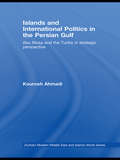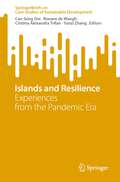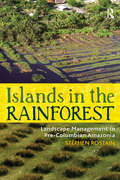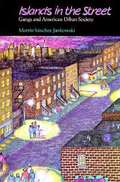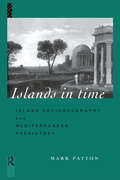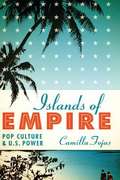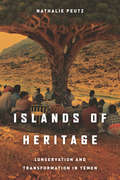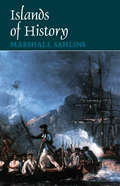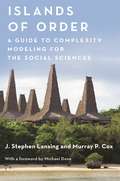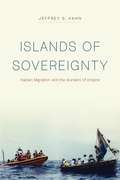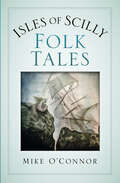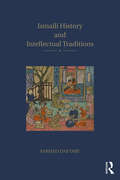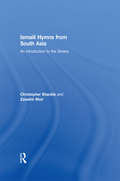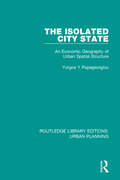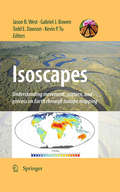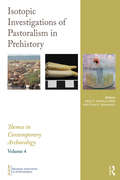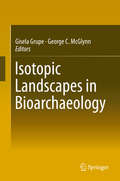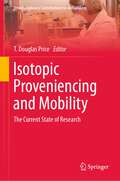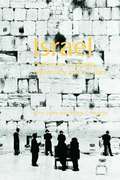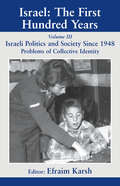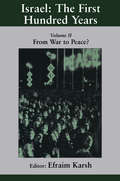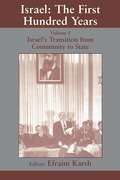- Table View
- List View
Islands and International Politics in the Persian Gulf: The Abu Musa and Tunbs in Strategic Context (Durham Modern Middle East and Islamic World Series)
by Kourosh AhmadiThe position of the Persian Gulf as the main highway between East and West has long given this region special significance both within the Middle East and in global affairs more generally. This book examines the history of international relations in the Gulf since the 1820s as great powers such as Britain and the US, and regional powers such as Iran and Iraq, vied for supremacy over this geopolitically vital region. It focuses on the struggle for control over the islands of the Gulf, in particular the three islands of Abu Musa, Greater Tunb and Lesser Tunb – an issue that remains highly contentious today. It describes how for 170 years Britain eroded Iranian influence in the Gulf, both directly by asserting colonial rule over Iranian islands and port districts, and also through claiming Iranian islands for their protégés on the Arab littoral. It shows how, after Britain's withdrawal, these islands became a pawn in the animosity and conflict that pitted, at one time, Arab radicals and nationalists against monarchical Iran, and, later, the conservative-moderate Arab camp against Islamic Iran. It goes on to explore the impact of the rise of American power in the Gulf since the start of the 1990s, its policy of containment of Iran and Iraq, and how this has provided encouragement to the ambitions of the Persian Gulf Arab littoral states, especially the UAE, towards the islands of the Gulf.
Islands and Resilience: Experiences from the Pandemic Era (SpringerBriefs on Case Studies of Sustainable Development)
by Can-Seng Ooi Roxane De Waegh Cristina Alexandra Trifan Yunzi ZhangThis book explores island resilience and how island communities come together to achieve wellbeing, have agency over their future and resist ongoing neo-colonialism during disruptive events such as COVID-19 and the increasing threats of climate change. This collection provides examples of lived experiences and the responses of island communities, many of them based in tourism-reliant locations. These examples are based on intensive research by a team of diverse academics and practitioners. The chapters offer case studies that interrogate theories related to resilience, wellbeing and social inclusion and provide cutting-edge insights that demonstrate the multifaceted complexity of island resilience.This book examines the islands, their developing economy and social development themes. It is relevant for academic researchers, students, and practitioners interested in the multiple components that contribute to the resilience of island communities, including community development, economic development, tourism, disaster response, community wellbeing, social justice, globalisation, decolonisation, and neoliberal governance in island communities. As many of the island economies examined are also developing island-states, this volume is also essential to scholars investigating economies in transition. The collection is truly interdisciplinary and offers state-of-the-art knowledge on island communities and their resilience.
Islands in the City: West Indian Migration to New York
by Nancy FonerThis collection of original essays draws on a variety of theoretical perspectives, methodologies, and empirical data to explore the effects of West Indian migration and to develop analytic frameworks to examine it.
Islands in the Rainforest: Landscape Management in Pre-Columbian Amazonia (New Frontiers in Historical Ecology)
by Stéphen RostainStéphen Rostain’s book is a culmination of 25 years of research on the extensive human modification of the wetlands environment of Guiana and how it reshapes our thinking of ancient settlement in lowland South America and other tropical zones. Rostain demonstrates that populations were capable of developing intensive raised-field agriculture, which supported significant human density, and construct causeways, habitation mounds, canals, and reservoirs to meet their needs. The work is comparative in every sense, drawing on ethnology, ethnohistory, ecology, and geography; contrasting island Guiana with other wetland regions around the world; and examining millennia of pre-Columbian settlement and colonial occupation alike. Rostain’s work demands a radical rethinking of conventional wisdom about settlement in tropical lowlands and landscape management by its inhabitants over the course of millennia.
Islands in the Street: Gangs and American Urban Society
by Martin S. Jankowski"Vivid, lively, and yet theoretically informed, a triumph of patient and sustained fieldwork. ... Jankowski presents the gang and its members not as pathological departures from social norms, but as shrewd and resourceful operators."--Michael Lipsky, Massachusetts Institute of Technology. "Islands in the Street fills a wide gap in the literature on gangs. Jankowski's innovative model of gang participation and organization is important and elegant, guaranteeing that this will be the book on gangs for the next ten years, if not longer."--Ruth Horowitz, University of Delaware.
Islands in Time: Island Sociogeography and Mediterranean Prehistory
by Mark PattonIslands in Time explores the ecological and cultural development of prehistoric island societies. It considers the prehistory of the Mediterranean and offers an explanation of the effects of isolation on the development of human communities. Evidence is drawn from a broad range of Mediterranean islands including Cyprus, Crete and the Cyclades, Malta, Lipari, Corsica and Sardinia.
Islands of Empire: Pop Culture and U.S. Power
by Camilla FojasCamilla Fojas explores a broad range of popular culture media-film, television, journalism, advertisements, travel writing, and literature-with an eye toward how the United States as an empire imagined its own military and economic projects. Impressive in its scope, Islands of Empire looks to Cuba, Guam, Hawai'i, Puerto Rico, and the Philippines, asking how popular narratives about these island outposts expressed the attitudes of the continent throughout the twentieth century. Through deep textual readings of Bataan, Victory at Sea, They Were Expendable, and Back to Bataan (Philippines); No Man Is an Island and Max Havoc: Curse of the Dragon (Guam); Cuba, Havana, and Dirty Dancing: Havana Nights (Cuba); Blue Hawaii, Gidget Goes Hawaiian, and Paradise, Hawaiian Style (Hawai'i); and West Side Story, Fame, and El Cantante (Puerto Rico), Fojas demonstrates how popular texts are inseparable from U. S. imperialist ideology. Drawing on an impressive array of archival evidence to provide historical context, Islands of Empire reveals the role of popular culture in creating and maintaining U. S. imperialism. Fojas's textual readings deftly move from location to location, exploring each island's relationship to the United States and its complementary role in popular culture. Tracing each outpost's varied and even contradictory political status, Fojas demonstrates that these works of popular culture mirror each location's shifting alignment to the U. S. empire, from coveted object to possession to enemy state.
Islands of Heritage: Conservation and Transformation in Yemen
by Nathalie PeutzSoqotra, the largest island of Yemen's Soqotra Archipelago, is one of the most uniquely diverse places in the world. A UNESCO natural World Heritage Site, the island is home not only to birds, reptiles, and plants found nowhere else on earth, but also to a rich cultural history and the endangered Soqotri language. Within the span of a decade, this Indian Ocean archipelago went from being among the most marginalized regions of Yemen to promoted for its outstanding global value. Islands of Heritage shares Soqotrans' stories to offer the first exploration of environmental conservation, heritage production, and development in an Arab state. Examining the multiple notions of heritage in play for twenty-first-century Soqotra, Nathalie Peutz narrates how everyday Soqotrans came to assemble, defend, and mobilize their cultural and linguistic heritage. These efforts, which diverged from outsiders' focus on the island's natural heritage, ultimately added to Soqotrans' calls for political and cultural change during the Yemeni Revolution. Islands of Heritage shows that far from being merely a conservative endeavor, the protection of heritage can have profoundly transformative, even revolutionary effects. Grassroots claims to heritage can be a potent form of political engagement with the most imminent concerns of the present: human rights, globalization, democracy, and sustainability.
Islands of History: Structure In The Early History Of The Sandwich Islands Kingdom (Asao Special Publications; Ser.)
by Marshall SahlinsMarshall Sahlins centers these essays on islands—Hawaii, Fiji, New Zealand—whose histories have intersected with European history. But he is also concerned with the insular thinking in Western scholarship that creates false dichotomies between past and present, between structure and event, between the individual and society. Sahlins's provocative reflections form a powerful critique of Western history and anthropology.
Islands of Order: A Guide to Complexity Modeling for the Social Sciences (Princeton Studies in Complexity #33)
by J. Stephen Lansing Murray P. CoxOver the past two decades, anthropologist J. Stephen Lansing and geneticist Murray Cox have explored dozens of villages on the islands of the Malay Archipelago, combining ethnographic research with research into genetic and linguistic markers to shed light on how these societies change over time. Islands of Order draws on their pioneering fieldwork to show how the science of complexity can be used to better understand unstable dynamics in culture, language, cooperation, and the emergence of hierarchies.Complexity science has opened exciting new vistas in physics and biology, but poses challenges for social scientists. What triggers fundamental, discontinuous social change? And what brings stable patterns—islands of order—into existence? Lansing and Cox begin with an incisive and accessible introduction to models of change, from simple random drift to coupled interactions, phase transitions, co-phylogenies, and adaptive landscapes. Then they take readers on a series of journeys to the islands of the Indo-Pacific to demonstrate how social scientists can harness these powerful tools to discover out-of-equilibrium social dynamics. Lansing and Cox address empirical questions surrounding the colonization of the Pacific, the relationship of language to culture, the emergence and disappearance of male and female hierarchies, and more.Unlocking new possibilities for the social sciences, Islands of Order is accompanied by an interactive companion website that enables readers to explore the models described in the book.
Islands of Sovereignty: Haitian Migration and the Borders of Empire (Chicago Series in Law and Society)
by Jeffrey S. KahnIn Islands of Sovereignty, anthropologist and legal scholar Jeffrey S. Kahn offers a new interpretation of the transformation of US borders during the late twentieth century and its implications for our understanding of the nation-state as a legal and political form. Kahn takes us on a voyage into the immigration tribunals of South Florida, the Coast Guard vessels patrolling the northern Caribbean, and the camps of Guantánamo Bay—once the world’s largest US-operated migrant detention facility—to explore how litigation concerning the fate of Haitian asylum seekers gave birth to a novel paradigm of offshore oceanic migration policing. Combining ethnography—in Haiti, at Guantánamo, and alongside US migration patrols in the Caribbean—with in-depth archival research, Kahn expounds a nuanced theory of liberal empire’s dynamic tensions and its racialized geographies of securitization. An innovative historical anthropology of the modern legal imagination, Islands of Sovereignty forces us to reconsider the significance of the rise of the current US immigration border and its relation to broader shifts in the legal infrastructure of contemporary nation-states across the globe.
Isles of Scilly Folk Tales
by Mike O'ConnorScilly has been its own unique land for centuries, separate from England and cut off from Cornwall by twenty-five miles of rough sea – yet until now its folk tales have been poorly documented. Let Anthony the droll-teller and his companions guide you on this voyage around the wonderful Isles of Scilly: a place of smugglers and shipwrecks, pirates and privateers, legends and long lost tales.
Ismaili History and Intellectual Traditions
by Farhad DaftaryThe Ismailis represent an important Shiʿi Muslim community with rich intellectual and literary traditions. The complex history of the Ismailis dates back to the second/eighth century when they separated from other Shiʿi groups under the leadership of their own imams. Soon afterwards, the Ismailis organised a dynamic, revolutionary movement, known as the daʿwa or mission, for uprooting the Sunni regime of the Abbasids and establishing a new Shiʿi caliphate headed by the Ismaili imam. By the end of the third/ninth century, the Ismaili dāʿīs, operating secretly on behalf of the movement, were active in almost every region of the Muslim world, from Central Asia and Persia to Yemen, Egypt and the Maghrib. This book brings together a collection of the best works from Farhad Daftary, one of the foremost authorities in the field. The studies cover a range of specialised topics related to Ismaili history, historiography, institutions, theology, law and philosophy, amongst other intellectual traditions elaborated by the Ismailis. The collation of these invaluable studies into one book will be of great interest to the Ismaili community as well to anyone studying Islam in general, or Shiʿi Islam in particular.
Ismaili Hymns from South Asia: An Introduction to the Ginans (Soas South Asian Texts Ser. #No. 3)
by Zawahir Moir Christopher ShackleThe Aga Khans have long played a prominent part on the international stage, but much less tends to be understood about the most important group of their followers, the Khoja Ismailis of South Asia, who are now also settled in many other parts of the world. Even less is generally known about the hymns, called ginans, which have historically formed so central an element in the religious life and rituals of the Ismaili community. The principal aim of this anthology is to fill this gap by providing a sympathetic introduction to this still largely unexplored tradition of South Asian devotional literature, and to draw attention to the many features of remarkable interest which it contains.
Isn't it Bromantic?: The Bromance Book Club is back ... it's time to find out more about our favourite Russian! (Bromance Book Club #9)
by Lyssa Kay AdamsIf you love Jasmine Guillory, Sally Thorne and Helen Hoang, you'll LOVE Lyssa Kay Adams!'The most inventive, refreshing concept in rom-coms!' Entertainment Weekly The Bromance Book Club was one of Bustle's '21 New Rom-Coms Out In Fall 2019 To Give You Warm And Fuzzy Feelings All Season Long'! 'A you're-gonna-burn-dinner book because you will not want to put it down. Laugh out loud with tons of heart, this is an absolutely adorable must read' Avery Flynn, USA Today bestselling author 'A delightful, fast-paced read with the perfect mix of laugh-out-loud and swoony moments - every town should have a Bromance Book Club' Evie Dunmore, author of Bringing Down the Duke 'It is the reading aloud in this story that ultimately wins my heart, and shows that everything worth knowing can be learned from romance' kc dyer, author of Finding Fraser With his passion for romance novels, it was only a matter of time before Vlad took up the pen to write a novel the Bromance Book Club would swoon over.He's ready to create his own sweeping romance - both on and off the page. Elena Konnikova has lived her entire adult life in the shadows. As the daughter of a Russian journalist who mysteriously disappeared, she escaped danger the only way she knew how. She agreed to marry her childhood friend, Vladimir, and move to the United States, where he is a professional hockey player in Nashville. Vlad, aka The Russian, thought he could be content with his marriage of convenience. But it's become too difficult to continue in a one-sided relationship. He joined the Bromance Book Club to learn how to make his wife love him, but all he's learned is that he deserves more. The Bros are unwilling to let Vlad forgo true love - and this time they're not operating solo, joining forces with Vlad's senior citizen neighbours, a group of meddling widows who call themselves The Loners. But just when things finally look promising, the danger from Elena's past life intrudes. Now the book club face their first-ever life-or-death grand gesture as they race to a happy ever after.Readers are LOVING Isn't It Bromantic!'Five stars for this sweet, sexy, funny read''Wow! What to say about this book? It was everything and more...I loved absolutely everything about this book' 'Sweet and heartfelt and lovely. Vlad is just an absolute love and I could read about him being in love in every book!''This book was the full package. Amazing plot, great characters, sexual chemistry, heart, humour, vulnerability... A masterclass on romance novel construction' 5* reader review'Heartfelt, sweet, emotional and tender... I can't get enough of this group of friends and I can't wait for the next addition!''I adored this book so much and flew through it so fast because I was loving it so much. I found myself laughing out loud multiple times... I just loved being back in this world with these characters so much!''Perfect for the summer holidays. An absolute feel-good romance with plenty of heart, laugh-out-loud scenes, and vulnerable yet strong characters. I couldn't put this book down'Don't miss the rest of the Bromance Book Club series: The Bromance Book Club, Undercover Bromance, and Crazy Stupid Bromance!!
Isn't That Rich?: Life Among the 1 Percent
by Richard Kirshenbaum Michael GrossCelebrated ad man Richard Kirshenbaum, the original New York observer, reveals the fashions, foibles, and outrageous extravagances of the private-jet set Paid friends. Pot dealers draped in Dolce. Divorce settlements that include the Birkins at their current retail price. Air kisses, landing strips, and lounge-chair bribery. For most of us, the idea of life inside the golden triad of Park Avenue, Sagaponack, and St. Barths is just as exotic as the mysteries of the Bermuda Triangle. Luckily, Richard Kirshenbaum has a VIP pass to the Upper East Side and is willing to share the wealth--of gossip. His New York Observer column on uptown social life provides a fascinating glimpse behind the gilded curtain into the swanky restaurants and eye-popping vacation destinations where the 1 percent gathers.Isn't That Rich? features highlights from Kirshenbaum's monthly column as well as several brand-new essays. From cash-strapped blue bloods willing to trade their good names for a taste of nouveau riche treasure to the fine art of donning a cashmere sweater in Capri, our intrepid correspondent exposes the preoccupations of the posh. His insider sources may be anonymous--Our Lady of the East River wouldn't have it any other way--but the light he shines on their world is dazzling and fabulously fun.
The Isolated City State: An Economic Geography of Urban Spatial Structure (Routledge Library Editions: Urban Planning #18)
by Yorgos PapageorgiouOriginally published in 1990, The Isolated City State asks the questions, why have the world’s major cities experienced explosive growth? Why does the socio-economic status in North America roughly increase with distance from the city centre, while the socio-economic status in South America roughly decreases? What are the reasons behind the sudden decline of some large, central cities? Will recovery if it happens be equally rapid? Generally, to understand the phenomenon, simplifications are made which make it impossible to understand other phenomena. This major study synthesises a vast amount of theorising and research to provide answers to the major questions of urban geography.
Isoscapes
by Gabriel J. Bowen Jason B. West Kevin P. Tu Todd E. DawsonStable isotope ratio variation in natural systems reflects the dynamics of Earth systems processes and imparts isotope labels to Earth materials. Carbon isotope ratios of atmospheric CO2 record exchange of carbon between the biosphere and the atmosphere; the incredible journeys of migrating monarchs is documented by hydrogen isotopes in their wings; and water carries an isotopic record of its source and history as it traverses the atmosphere and land surface. Through these and many other examples, improved understanding of spatio-temporal isotopic variation in Earth systems is leading to innovative new approaches to scientific problem-solving. This volume provides a comprehensive overview of the theory, methods, and applications that are enabling new disciplinary and cross-disciplinary advances through the study of "isoscapes": isotopic landscapes. "This impressive new volume shows scientists deciphering and using the natural isotope landscapes that subtly adorn our spaceship Earth.", Brian Fry, Coastal Ecology Institute, Louisiana State University, USA "An excellent timely must read and must-have reference book for anybody interested or engaged in applying stable isotope signatures to questions in e.g. Anthropology, Biogeochemistry, Ecology, or Forensic Science regarding chronological and spatial movement, changes, or distribution relating to animals, humans, plants, or water.", Wolfram Meier-Augenstein, Centre for Anatomy & Human Identification, University of Dundee, UK "Natural resources are being affected by global change, but exactly where, how, and at what pace? Isoscapes provide new and remarkably precise answers.", John Hayes, Woods Hole Oceanographic Institution, USA "This exciting volume is shaping a new landscape in environmental sciences that is utilizing the remarkable advances in isotope research to enhance and extend the capabilities of the field.", Dan Yakir, Weizmann Institute of Science, Israel
Isotopic Investigations of Pastoralism in Prehistory (Themes in Contemporary Archaeology)
by Alicia R. Ventresca Miller Cheryl A. MakarewiczPastoralists were a vital economic and social force in ancient societies around the globe, transforming landscapes poorly suited for agriculture into spaces of vast productive potential while simultaneously connecting mobile and sedentary communities alike across considerable distances. Drawing from the rich archaeological records of Asia, Africa, and Europe, Isotopic Investigations of Pastoralism in Prehistory brings together the latest studies employing heavy and light stable isotopic analyses of humans and animals to investigate pastoralist diets, movement, and animal management strategies. The contributions presented in this volume highlight new methodological developments while simultaneously drawing attention to the diverse environmental factors that contribute to isotopic variation in human, plant, and animal tissues. Particular attention is paid to how pastoralist decisions regarding animal pasturing and mobility can be teased out of complex isotopic datasets, and also to the challenges in extracting information on the scales of human mobility in pastoralist landscapes. This volume will appeal to scholars in archaeology, anthropology, and ecology, as well as those with interests in animal management.
Isotopic Landscapes in Bioarchaeology
by Gisela Grupe George C. McglynnThis work takes a critical look at the current concept of isotopic landscapes ("isoscapes") in bioarchaeology and its application in future research. It specifically addresses the research potential of cremated finds, a somewhat neglected bioarchaeological substrate, resulting primarily from the inherent osteological challenges and complex mineralogy associated with it. In addition, for the first time data mining methods are applied. The chapters are the outcome of an international workshop sponsored by the German Science Foundation and the Centre of Advanced Studies at the Ludwig-Maximilian-University in Munich. Isotopic landscapes are indispensable tracers for the monitoring of the flow of matter through geo/ecological systems since they comprise existing temporally and spatially defined stable isotopic patterns found in geological and ecological samples. Analyses of stable isotopes of the elements nitrogen, carbon, oxygen, strontium, and lead are routinely utilized in bioarchaeology to reconstruct biodiversity, palaeodiet, palaeoecology, palaeoclimate, migration and trade. The interpretive power of stable isotopic ratios depends not only on firm, testable hypotheses, but most importantly on the cooperative networking of scientists from both natural and social sciences. Application of multi-isotopic tracers generates isotopic patterns with multiple dimensions, which accurately characterize a find, but can only be interpreted by use of modern data mining methods.
Isotopic Proveniencing and Mobility: The Current State of Research (Interdisciplinary Contributions to Archaeology)
by T. Douglas PriceThis volume provides a state-of-the-art presentation and discussion of procedures, especially what works and what doesn’t — on isotopic proveniencing, learned over the last 30 years. The volume focuses on application, not method, to emphasize to the reader the wide range of questions that can be addressed using isotopic proveniencing. Topics covered include samples, baselines, isoscapes, and place of origin. Isotopic proveniencing has become almost standard procedure in the analysis of archaeological burials as a means of distinguishing locals from foreigners. The combination of isotopic proveniencing and DNA has moved archaeological interest in migration and mobility to the fore, but there is very little synthetic work published for either technology.The field has evolved and new procedures and guidelines have emerged that have not been widely heard and this volume seeks to rectify this. The contributors have been selected from among the leaders in the field, those with active research and hands-on experience with the technology. This volume is of relevance to archaeologists.
Israel: Challenges to Identity, Democracy and the State (The Contemporary Middle East)
by Clive Jones Emma C. MurphyOften regarded as the only true manifestation of political pluralism in the contemporary Middle East, the state of Israel has dominated the history and politics of the region for over fifty years. Yet despite its position as a regional superpower, Israel continues to struggle with the whole issue of its own identity, the complexities of which have exposed deep clefts throughout Israeli society that threaten to undermine the collective ideal of a viable Jewish polity in the Middle East. The authors explore the complex challenges facing Israel, and the extent to which its present state structures and institutions can adapt and accommodate themselves to the diversity of security threats that it now faces. This book will be of interest to those who wish to understand the dynamics that have shaped and continue to shape the state of Israel, and the extent to which these have influenced its search for security in the modern Middle East.
Israel: Volume III: Politics and Society since 1948 (Israeli History, Politics and Society #Vol. 2)
by Efraim KarshSince its founding in 1948 Israel has faced many political, social and psychological challenges, unfamiliar to other nations on the western democratic political model and peculiar to the Jewish state. This work covers the role of politics in Israel since 1948.
Israel: Volume II: From War to Peace? (Israeli History, Politics and Society #Vol. 2)
by Efraim KarshThe end of the British mandate in Palestine heralded the birth of the new state of Israel. It also marked the end of one of the most tumultuous and momentous chapters in Israeli history. But the new state, born into a hostile environment and struggling with the manifold demands of sovereignty, would have to face many post-Independence challenges to its existence, not least in the form of armed conflict and confrontation with its Arab neighbours. This volume examines the conflicts that from the 1948 until the 1967 Six Day War came to define the Israeli struggle for existence.
Israel: Volume I: Israel’s Transition from Community to State (Israeli History, Politics and Society #Vol. 2)
by Efraim KarshThe Zionist Movement was born in the wake of Jewish emancipation in Western Europe, and at a time of increased persecution in Eastern Europe. This volume addresses the intellectual, social and political ramifications of Jewish settlement in Eretz Israel before the creation of the State of Israel.
